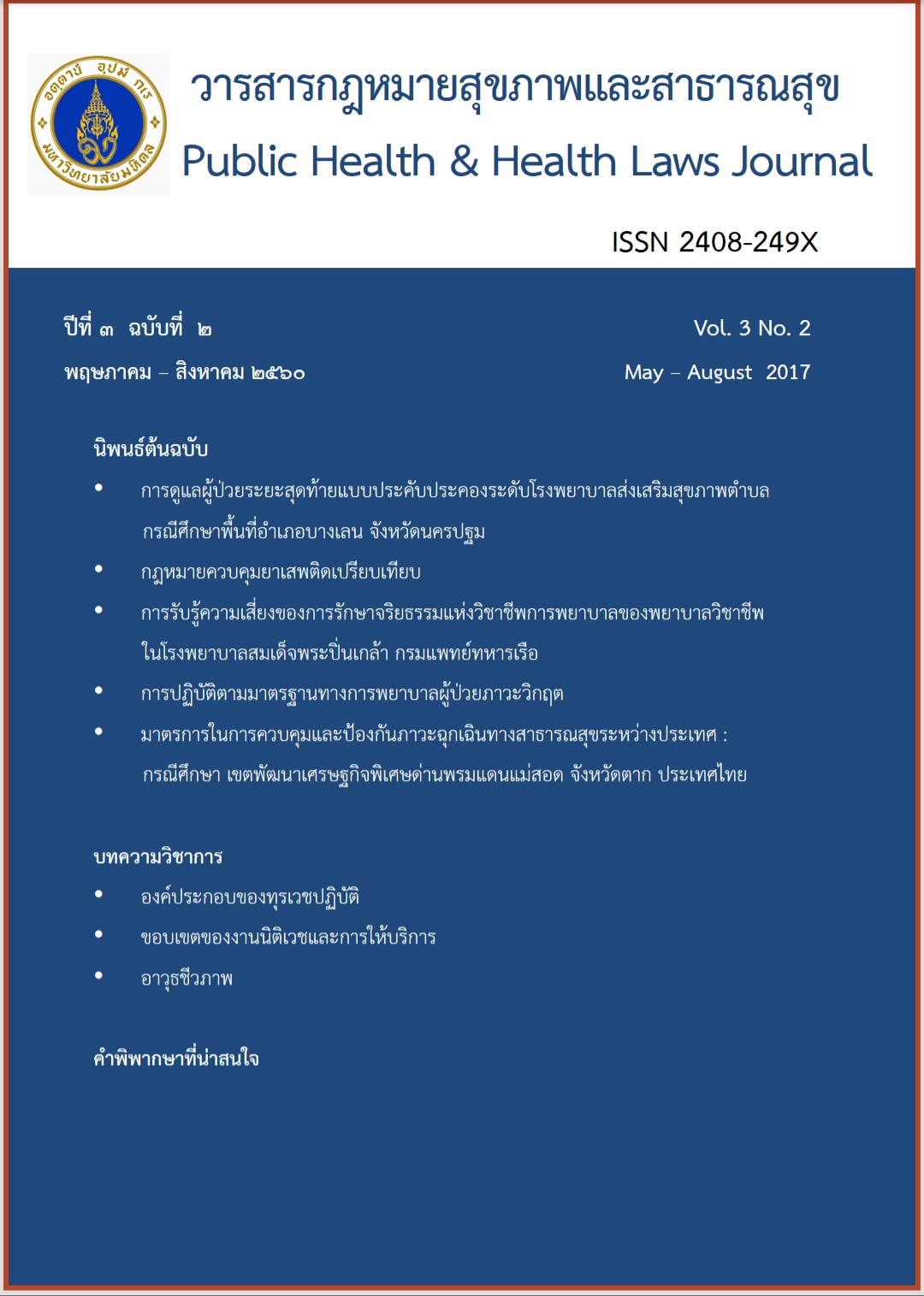Comparative Drug Control Law
Keywords:
Comparative Drug Control Law, Thailand, Japan, the United States of America, the United Kingdom, NetherlandsAbstract
This study is a documentary research, reviewing and comparing drug laws of Thailand, Japan, USA, England and the Netherlands. It was found that Japan implemented a strict policy against narcotics, with preventive measures to protect harmful health effects, and treatment for addicts. For Netherlands, the state established treatment systems for drug users, educating the dangers of addictive substances on society and schools. This included a hotline counseling system, harm reduction from drug abuse policy, and forced treatment for repeated drug addicts. For United Kingdom or England, it had a more lenient policy on narcotic addiction. This was because drug abuse strategies in the past were not effective at reducing illegal drug use and distribution. The British government therefore developed a 2008-2018 Drug Strategy Plan. For the United States, the federal policy was still strict, but at the state level, it began to gradually adopt a more lenient policy on drug offenses, by looking at addicts as patients rather than criminals.
Based on the review of the laws in five countries, there are four recommendations: prevention, suppression, treatment and criminal mitigation of non-fatal addictive substances, such as personal use of marijuana, or possession of marijuana. These would have intermediate punishments such as contributing for social services, imprisonment, or under strict detention, etc. However, if a person is under severe addiction, he/she will be forced to undergo a compulsory treatment program. Drug users, who are under medical considerations as patients, should be given more opportunities to return to society with dignity, although they may take several sessions of treatment.
References
ศิริพล กุศลศิลป์วุฒิ. (มปป.). การลดความผิดยาเสพติด และการลดอันตรายผู้เสพยาเสพติด. สถาบันฝึกอบรมระหว่างประเทศเพื่อให้เป็นไปตามกฎหมาย สำนักงานตำรวจแห่งชาติ สถาบันฝึกอบรมระหว่างประเทศเพื่อให้เป็นไปตามกฎหมาย. สืบค้นเมื่อ 10 มิถุนายน 2558. Available at http://www.bloggang.com/mainblog.php?id=jurisprudence&month=22-08-2014&group=24&gblog=59
Nutt, David J; Leslie A King ; Lawrence D Phillips. (2010, 6 November). "Drug harms in the UK: a multicriteria decision analysis". The Lancet. 376 (9752): 1558–1565..
Csete, J. et al. (2011), ‘Compulsory drug detention centre experiences among a community-based sample of injection drug users in Bangkok, Thailand’, BMC International Health and Human Rights, 11: 12. doi:10.1186/1472-698X-11-12, Available at http://www.biomedcentral.com/1472-698X/11/12
Davies C, English L, ,Stewart C, Lodwick A, McVeigh J, Bellis MA. (2011). United Kingdom: Drug Situation 2011 EDITION, UK Focal Point On Drugs. Annual Report to the European Monitoring Centre for Drugs and Drug Addiction (EMCDDA).
EMCDDA (2012). (The European Monitoring Centre for Drugs and Drug Addiction). Legal Topic Overviews: Penalties for Illegal Drug Trafficking. Available at http://www.emcdda.europa.eu/html.cfm/index5036EN.html, 26 January 2012.
Englsman E. L. (1989). Dutch Policy on the Management of Drug-related Problems. Version of Record online: 24 JAN 2006. Issue British Journal of Addiction. British Journal of Addiction Volume 84, Issue 2, pages 211–218, February 1989.
Office of National Drug Control Policy. (2015) National Drug Control Strategy. Available at https://www.whitehouse.gov/ondcp/national-drug-control-strategy
Greberman Bowman, Sharyn and Wada, Kiyoshi. (1994) “Social and Legal Factors Related to Drug Abuse in the United States and Japan.” Public Health Reports, Vol. 109, No. 6 (Nov. - Dec., 1994), pp. 731-737
European Monitoring Centre for Drugs and Drug Addiction (EMCDDA). Annual Report The state of the drugs problem in Europe. 2010;24. Available at:http://www.emcdda.europa.eu/online/annual-report/2010/policies-law/5(accessed 25 October 2011; archived by WebCite® athttp://www.webcitation.org/62h9xzMfd).
Marcel De Kort and Dirk J. Korf. (1992). The development of drug trade and drug control in the Netherlands: a historical perspective. Crime, Law and Social Change 17: 123-144, 1992.
Toshiyoshi Tominaga, (2005). Control on Medical Narcotics in Japan -Science & Policy Compliance and Narcotics Div. Pharmaceutical and Food Safety Bureau Ministry of Health, Labor, and Welfare. 2005 International Symposium on Drug Control Strategy, 26 October.
United Nations (1961) 1962/914(XXXIV)D. The Single Convention on Narcotic Drugs 1961 3 Aug. 1962. Available at https://www.unodc.org/pdf/convention_1961_en.pdf accessed on January 15, 2016.
United Nations. (1971) Convention on Psychotropic Substances, 1971 Available at https://www.unodc.org/pdf/convention_1971_en.pdf accessed on January 15, 2016.
United Nations. (2004). Convention against Transnational Organized Crime .
United Nations Office on Drugs and Crime & World Health Organisation (2008), Principles of drug dependence treatment (Vienna: United Nations Office on Drugs and Crime), p. 1, Available at https://www.unodc.org/documents/drug-treatment/UNODC-WHO-Principles-of-Drug-Dependence-Treatment-March08.pdf
United Nations (2012), Joint statement – Compulsory drug detention and rehabilitation centres, Available at http://www.unaids.org/en/media/unaids/contentassets/documents/document/2012/JC2310_Joint%20Statement6March12FINAL_en.pdf
United Nations Office on Drugs and Crime (2013), World Drug Report, Available at http://www.unodc.org/wdr/
United States (2015) Department of State Bureau for International Narcotics and Law Enforcement Affairs International Narcotics Control Strategy Report Volume I Drug and Chemical Control, March. Available at http://www.state.gov/documents/organization/239560.pdf
Downloads
Published
How to Cite
Issue
Section
License
Disclaimer and Copyright Notice
The content and information presented in articles published in the Journal of Law and Public Health Policy represent the opinions and sole responsibility of the respective authors. The editorial board does not necessarily agree with or assume any responsibility for the views expressed.
All articles, data, content, images, and other materials published in the Journal of Law and Public Health Policy are the intellectual property of the journal. Any individual or organization wishing to reproduce, distribute, or otherwise use the entirety or any part of such materials must provide proper citation.





